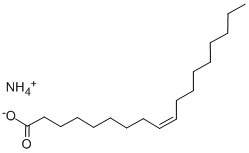9Z-octadecenoylethanolamide , 95% , 111-58-0
Synonym(s):
oleoylethanolamide;OEA;9Z-octadecenoylethanolamide;N-(cis-9-Octadecenoyl)ethanolamine;N-(Hydroxyethyl)oleamide
CAS NO.:111-58-0
Empirical Formula: C20H39NO2
Molecular Weight: 325.53
MDL number: MFCD00045972
EINECS: 203-884-8
| Pack Size | Price | Stock | Quantity |
| 1g | RMB223.20 | In Stock |
|
| 5G | RMB671.20 | In Stock |
|
| 25g | RMB1999.20 | In Stock |
|
| 100g | RMB6399.20 | In Stock |
|
| others | Enquire |
PRODUCT Properties
| Melting point: | 63-64 °C |
| Boiling point: | 496.4±38.0 °C(Predicted) |
| Density | 0.915±0.06 g/cm3(Predicted) |
| storage temp. | -20°C |
| solubility | Soluble in DMSO (up to 25 mg/ml) or in Ethanol (up to 35 mg/ml) |
| pka | 14.49±0.10(Predicted) |
| form | White solid |
| color | White |
| Stability: | Stable for 2 years from date of purchase as supplied. Solutions in DMSO or ethanol may be stored at -20°C for up to 1 month. |
| InChI | InChI=1S/C20H39NO2/c1-2-3-4-5-6-7-8-9-10-11-12-13-14-15-16-17-20(23)21-18-19-22/h9-10,22H,2-8,11-19H2,1H3,(H,21,23)/b10-9- |
| InChIKey | BOWVQLFMWHZBEF-KTKRTIGZSA-N |
| SMILES | C(NCCO)(=O)CCCCCCC/C=C\CCCCCCCC |
| LogP | 6.406 (est) |
| CAS DataBase Reference | 111-58-0(CAS DataBase Reference) |
| EPA Substance Registry System | 9-Octadecenamide, N-(2-hydroxyethyl)-, (9Z)- (111-58-0) |
Description and Uses
Oleoyl ethanolamide (OEA) is an analog of the endocannabinoid AEA found in brain tissue and in chocolate. It is one of the long chain fatty acid ethanolamides that accumulates rapidly in infarcted tissue, but its biosynthesis is reduced in the intestine of rats following food deprivation. OEA is an endogenous, potent agonist for PPARα, exhibiting an EC50 value of 120 nM in a transactivation assay. Systemic administration of OEA suppresses food intake and reduces weight gain in rats (10 mg/kg intraperitoneally) and PPARα wild-
N-Oleoyl Ethanolamide is an agonist of peroxisome proliferator-activated receptor-α (PPAR-α). N-Oleoyl Ethanolamide generates an intestinal signal that stimulates central dopamine activity establishing a link between caloric-homeostatic and hedonic-homeostatic controllers. Oleoyl Ethanolamide has been implicated as the molecular mechanism associated with gastric bypass success. N-Oleoyl Ethanolamide is a selective GPR55 agonist.
Safety
| Symbol(GHS) |   GHS09,GHS05 |
| Signal word | Danger |
| Hazard statements | H315-H411-H318 |
| Precautionary statements | P264-P280-P302+P352-P321-P332+P313-P362-P280-P305+P351+P338-P310 |
| Hazard Codes | Xi |
| Risk Statements | 36/37/38 |
| Safety Statements | 26-36 |
| WGK Germany | 2 |
| HazardClass | IRRITANT |





